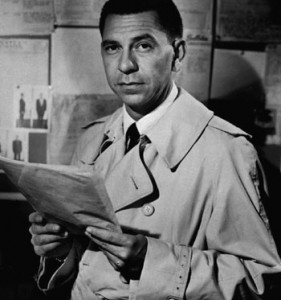Podcast: Play in new window | Download
Subscribe: Apple Podcasts | Email | RSS

Today’s Mystery:
An organist is found murdered in her apartment, and the police can figure out the killer got in.
Original Radio Broadcast Date: December 15, 1949
Originating from Hollywood
Starring: Jack Webb as Sergeant Joe Friday; Barton Yarborough as Sergeant Ben Romero; Herb Butterfield
Support the show monthly at patreon.greatdetectives.net
Patreon Supporter of the Day: Blaine, Patreon Supporter Since January 2017
Support the show on a one-time basis at http://support.greatdetectives.net.
Mail a donation to: Adam Graham, PO Box 15913, Boise, Idaho 83715
Take the listener survey at http://survey.greatdetectives.net
Give us a call at 208-991-4783
Follow us on Instagram at http://instagram.com/greatdetectives
Follow us on Twitter @radiodetectives
Join us again on Monday for another detective drama from the Golden Age of Radio.

Hi Adam!
Just a few words about “The Garbage Chute Murder” (1949), I find it odd that the emphasis is placed on how the killer got into the locked-from-within apartment as opposed to just how he managed to get out! Given the emphasis on the latter, it could’ve been an example of that detective-fiction subgenre, “the locked-room mystery”, in which a major problem is how the crime could’ve been committed at all! The genesis of this form of fiction was originated by Edgar Allan Poe’s 1841 short story, “The Murders in the Rue Morgue”, as too the detective story itself as it came to be known a long time later; but strangely enough, the vast potential of each theme, both brilliantly executed by Poe, didn’t catch on for decades! John Dickson Carr (1906 — 1977), starting in 1930, would become the foremost practitioner of the “impossible crime” story, with varying results. I was, and am, an admirer of Carr, but find it irritating when his sleuths brag from the outset how they immediately know how a seemingly miraculous murder was achieved, also bothersome when the solution entails pages of explanation. Such is the situation in his 1935 novel, “The Hollow Man”, but it’s generally considered a masterpiece notwithstanding. How much more enjoyable to me is “The Bowstring Murders” (1933), with Carr’s one-time use of the pseudonym, “Carr Dickson”. He himself didn’t consider this one of his better efforts, but its “impossible” homicide is excellent, and mysteriously presented within an old castle albeit with a solution that’s a modified version of a Houdini gimmick. One of Carr’s most adroit solutions to a seemingly invisible murderer is contained in “The Crooked Hinge” (1938), with his earlier novel, “The Burning Court” (1937), a tour-de-force for, not only its apparently supernatural killing, but its double-twist finale wherein an intricate and logical denouement to the mystery is followed — shockingly — by a genuinely, and acceptable, supernatural one!